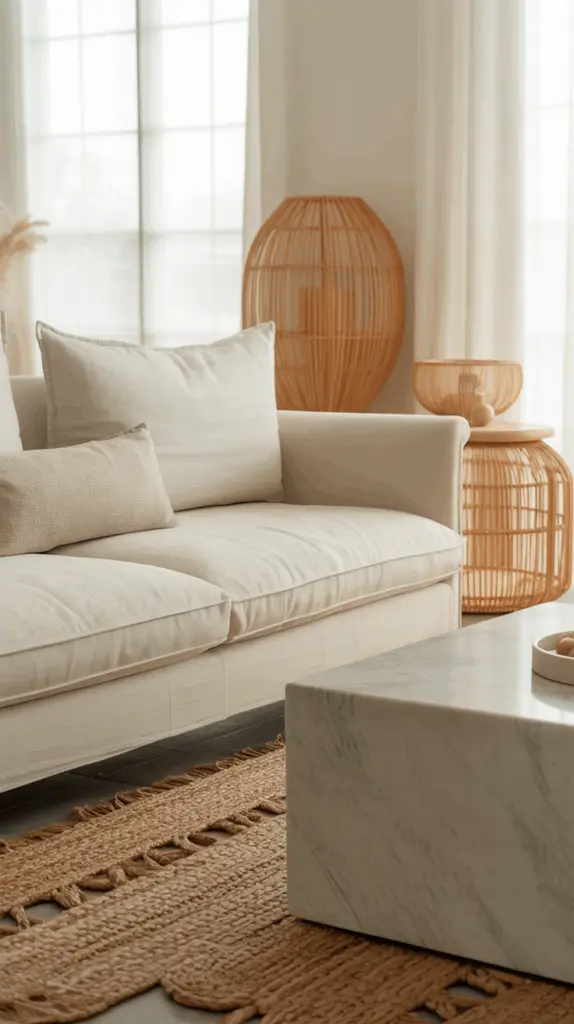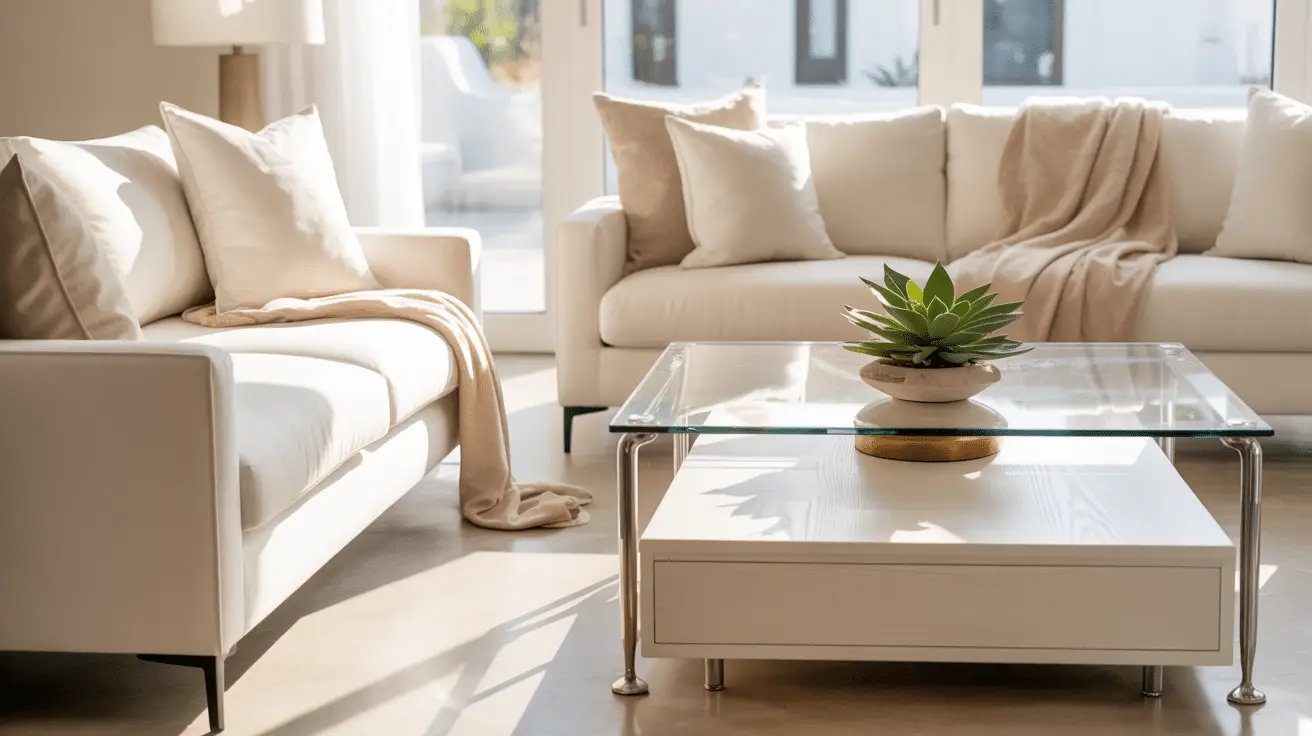Stunning White Living Room Ideas for Effortless Elegance and Timeless Style
Table of Contents
Introduction
There’s a reason white living rooms never go out of style—they exude a sense of calm, light, and sophistication that few other palettes can match. In fact, according to interior design studies, homes with predominantly white or neutral interiors often feel up to 30% more spacious and bright. White has the remarkable ability to make any room feel serene yet refined, acting as a perfect blank canvas for creativity and comfort.
A stunning white living room isn’t just about painting the walls ivory and calling it done—it’s about layering textures, blending tones, and curating pieces that bring warmth and personality to a clean, minimal palette. The beauty of white is its versatility: it can feel coastal and breezy, modern and minimal, or traditional and cozy depending on how it’s styled.
In this article, we’ll explore how to design a white living room that feels luxurious but lived-in, sophisticated yet welcoming. You’ll learn how to work with contrast, integrate texture, and add the right lighting and decor elements to achieve that perfect balance of effortlessness and elegance.
Choosing the Perfect Shade of White
Not all whites are created equal. In fact, designers often compare finding the perfect white to selecting the perfect lighting—it all depends on undertones, light exposure, and the mood you want to create.
Cool whites (with hints of blue or gray) suit modern and minimalist spaces, while warm whites (with yellow or beige undertones) create a cozier and more inviting feel. If your living room receives a lot of natural light, you can lean toward cooler whites for a crisp effect. In low-light areas, warm whites prevent the space from feeling sterile.
| Type of White | Undertone | Ideal Use | Design Tip |
| Cool White | Blue or Gray | Modern, urban interiors | Pair with chrome or glass decor |
| Warm White | Yellow or Cream | Traditional, rustic rooms | Combine with natural wood tones |
| Neutral White | Balanced | Versatile, adaptable | Works well in layered palettes |
When selecting paint, test several swatches at different times of the day. Light shifts throughout morning and evening can alter how white appears, transforming it from fresh to flat if not chosen carefully.
Layering Textures for Warmth and Depth
White spaces thrive on texture. Without it, they can quickly feel flat or sterile. Layering tactile materials—like linen, wool, rattan, and marble—creates visual interest and cozy dimension without disrupting the neutral palette.
Start with foundational textures: a plush area rug, soft fabric sofa, or woven throw. Add contrast through smooth materials like glass, stone, or metal. Mixing matte and glossy finishes also brings the space to life.
| Texture Type | Material Example | Best Use | Adds To |
| Soft | Wool, Linen, Cotton | Sofas, cushions, rugs | Comfort & coziness |
| Natural | Rattan, Wood, Jute | Tables, baskets | Organic warmth |
| Sleek | Marble, Glass, Metal | Surfaces, lighting | Modern sophistication |
For example, a white linen sofa paired with a chunky knit blanket and a marble coffee table captures both comfort and elegance. Balance is key—too much softness can look washed out, while too much shine can feel cold.

Balancing White with Contrast and Accents
Contrast keeps a white living room from feeling one-dimensional. Introducing small but strategic doses of darker or bolder hues grounds the space and highlights your design details.
A common technique is to incorporate black, bronze, or wood tones through furniture legs, lighting fixtures, or frames. These elements create depth while preserving the airy elegance of the room. You can also use soft pastels or metallics as subtle accents for added sophistication.
| Accent Color | Best Paired Material | Effect Created |
| Black | Metal, Wood | Adds structure and definition |
| Gold | Brass, Mirror | Introduces warmth and luxury |
| Green | Plants, Artwork | Refreshes the white palette |
| Beige or Taupe | Textiles | Maintains balance and serenity |
Consider adding accent pillows, art, or ceramics in gentle contrast shades. This approach gives your white space personality while keeping it timeless and cohesive.
Lighting the White Living Room Beautifully
Lighting is the heartbeat of any white interior. It enhances the nuances between tones and amplifies the room’s serene ambiance. To truly make your white living room glow, layer multiple light sources—natural, ambient, task, and accent lighting.
Natural light is ideal, so opt for sheer curtains or blinds that diffuse rather than block sunlight. In the evenings, warm-toned lighting (2700K–3000K) keeps the space cozy. Combine ceiling lights with wall sconces or table lamps for flexibility.
| Lighting Type | Function | Design Tip |
| Ambient | Overall illumination | Use warm LED bulbs to soften brightness |
| Task | Focused light | Add lamps near reading areas |
| Accent | Highlight features | Place near art or decor for depth |
The interplay between light and shadow accentuates texture and gives your all-white space a sophisticated depth. Add reflective surfaces like glass, mirrors, or glossy ceramics to bounce light around and make the room feel expansive.
Choosing the Right Furniture and Layout
Furniture anchors your white living room design. The trick is to balance form and function while keeping the palette cohesive. Opt for streamlined pieces that complement the light color scheme but vary in material or tone for interest.
White or beige sofas are classic choices, but introduce contrast through wooden tables, rattan chairs, or matte black legs. Modular furniture helps maintain an open layout, essential for smaller spaces.
| Furniture Type | Suggested Finish | Ideal Placement |
| Sofa | White, Cream, or Light Gray | Centered focal point |
| Coffee Table | Wood, Marble, or Glass | Adds depth and texture |
| Accent Chairs | Woven or upholstered | Breaks monotony |
| Storage | Built-in white cabinetry | Keeps space uncluttered |
Arrange furniture to promote openness and flow. Avoid blocking light sources and maintain visual balance by distributing color and weight evenly across the room.
Infusing Warmth with Natural Elements
White interiors can sometimes feel too pristine, but incorporating natural elements ensures a sense of comfort and harmony. Wood tones, greenery, and stone accents instantly make the space more inviting.
A white room paired with light oak floors, driftwood tables, or wicker baskets feels grounded and cozy. Plants—whether potted palms or small succulents—add vibrancy and movement, breaking the monochrome in a refreshing way.
| Natural Element | Ideal Use | Adds |
| Wood | Furniture, floors | Warmth & texture |
| Plants | Corners, shelves | Color & life |
| Stone | Surfaces, accessories | Organic depth |
These elements enhance the white palette’s versatility, proving that elegance doesn’t have to feel cold. The interplay of nature-inspired textures ensures the room feels sophisticated yet soulful.
Styling with Minimalist Decor and Accessories
When it comes to decorating a white living room, restraint is essential. The goal is effortless elegance, not cluttered perfection. Choose accessories intentionally—each piece should add value to the overall design.
Opt for sculptural vases, monochrome artwork, or textural throws that blend seamlessly with the neutral scheme. Layer decor in threes for balanced visual rhythm.
| Decor Type | Best Placement | Design Purpose |
| Art & Prints | Above sofa or console | Adds personality |
| Textiles | Cushions & blankets | Introduces pattern softly |
| Mirrors | Opposite windows | Enhances light & space |
| Ceramics | Coffee or side tables | Brings tactile beauty |
Keep surfaces like coffee tables minimal—perhaps one statement vase or a small stack of books. The less-is-more approach highlights the architecture and natural light that make white interiors so captivating.
Adding Subtle Glamour Through Finishes
White living rooms can easily embrace a touch of glamour without losing their serenity. Subtle metallics—gold, brass, or chrome—add sophistication through lighting, frames, and accent furniture. Mirrored surfaces and soft sheen fabrics like silk or velvet bring understated luxury.
| Finish Type | Application | Result |
| Gold/Brass | Lighting & decor | Warm, refined glow |
| Chrome | Furniture & accents | Sleek modernity |
| Velvet/Silk | Cushions & drapery | Elegant texture |
| Glass | Tables & mirrors | Airy, reflective charm |
By layering these glossy or reflective materials, you create a luminous, upscale aesthetic while maintaining the clean, minimal foundation of a white space.
Conclusion
Designing a stunning white living room is an art of balance—between simplicity and warmth, structure and softness. White interiors radiate effortless elegance when infused with thoughtful details: textured layers, natural elements, gentle contrasts, and a hint of shine.
The result is a space that feels both timeless and tranquil, sophisticated yet deeply livable. Whether you prefer a modern minimalist approach or a cozy classic vibe, a well-curated white living room becomes the ultimate expression of refined comfort and lasting beauty.

